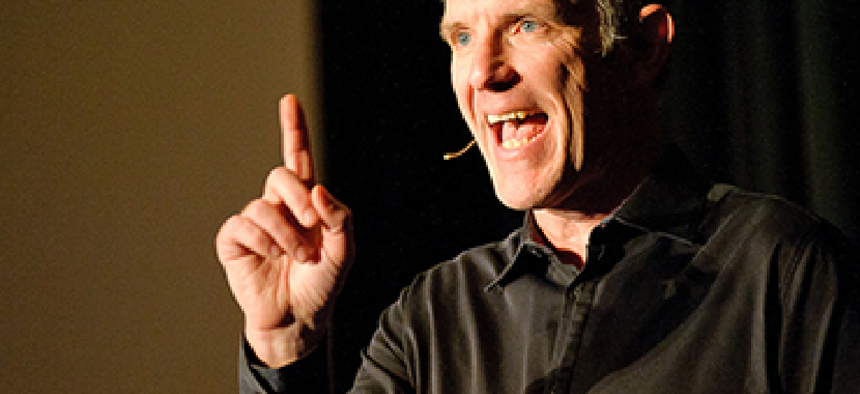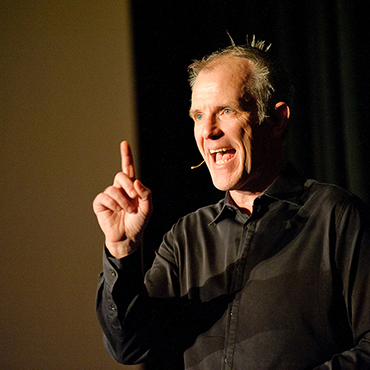6 lessons for feds from Silicon Valley (plus 3 that really don't apply)

Tech entrepreneurs' leadership goals are strikingly similar to those of agency IT executives. But the obstacles to getting there can be very, very different.

Too many 'mutated meetings' are counterproductive, says Palantir's Michael Lopp. (Photo: Flickr/O'Reilly Conferences)
Creating a culture of success is hard. Federal IT leaders are all too familiar with the hurdles of Byzantine procurement, sequestered budgets and pockets of change-averse employees, but even the most nimble tech startups struggle to make excellence part of their DNA.
On Oct. 14 in New York City, some 150 executives, senior software engineers and others hoping to crack the code of "leading through culture" gathered for O'Reilly Media's first Cultivate conference. Here's what feds could take away from the discussions:
1. First, let's kill all the meetings
GitHub co-founder Schott Chacon said that his firm rarely convened meetings, for the simple reason that its 215 employees are distributed across several dozen cities around the globe. "There is literally no time" that works for everyone, Chacon said.
The aversion to meetings goes beyond logistics, however. GitHub is devoted to open-source collaboration, and the business itself runs much like an open-source project, Chacon said: "Everything is asynchronous," and there are no set work hours. Moreover, live meetings can favor the louder or more senior participants, even if others have better ideas. And "if you can't make the meeting, are you a second-class citizen?"
"You have to ask, why are you having a meeting," Chacon said. "Are there any better ways to address those principles?"
According to Palantir Technologies' Michael Lopp, the answer is almost always "yes." While Lopp, who is also a veteran of Apple and Netscape, argued for certain types of well structured "preventive maintenance" meetings, he warned that calendars too often become clogged with "mutated meetings." Clear warning signs are attendees there for no discernible reason and who aren't contributing; no agenda; a lack of respect for attendees' time; and recurring schedules that go on "forever and ever."
"If you do the math," Lopp quipped, forever "is a really long time."
"Groups of people do not instinctively communicate at scale," he said. "You need to build machinery around these humans to help them," and guard against meeting creep.
2. Whom (and how) do you trust?
Trust is critical for working relationships, of course (see #4 below), but the type of trust an agency or team allocates to employees fundamentally shapes how that organization operates. Elaine Wherry, a co-founder of the Google-acquired social-media firm Meebo, said that trust is often given by default in startups, while larger, more established organizations require new hires to earn trust -- through either structured systems or unofficial time served.
Earned-trust teams are more structured and scale better, Wherry said, but too often make employees feel like "cogs in the machine." Granted-trust teams, on the other hand, encourage innovation and keep top-flight employees happy and engaged -- but are chaotic, difficult to scale and "really raise the bar on hiring."
Successful organizations, Wherry added, often swing sharply from granted trust to earned trust as they grow, before settled back into a happy medium. The online shoe retailer Zappos, for example, puts new hires through an intensive period of training and indoctrination before bestowing real trust. The company pays those with second thoughts $2,000 to quit. Once in, however, Zappos employees are assumed to be all in -- and trusted accordingly.
3. Hiring isn't everything. But it's close
KISSmetrics co-founder Hiten Shah distilled it down to a recent tweet from Box's Sam Schillace: "Hire the most amazing people you can. Communicate goals. Turn them loose. Profit."
Former Netflix Chief Talent Officer Patty McCord went deeper, stressing that
leaders must have a clear vision for what they want their organization to do before they hire -- or assess existing team members.
"To build the right team, you must know what you are going to build," said McCord, who also held senior human resources roles for Seagate Technologies, Borland and Sun Microsystems, and now runs her own consulting firm. And "if you start with the team that you have, you may be limited by what you know or believe they can do."
Giving team members both a plan and freedom in how they pursue it brings another "huge benefit," GitHub's Chacon noted. "It lets you get more people of different types into your organization," he said. If you want people who are married, have families, or live elsewhere, "you need to be flexible."
In addition to core technical skills, McCord suggested character traits to observe in prospective hires and inherited employees:
- how they respond to change;
- how they respond to challenge;
- how they respond to the unknown;
- how they respond to each other;
- how they respond to unexpected interruption;
- how they respond to learning.
Even in a big organization, she said, "you can create your own teams the way you want to create them."
And Stripe co-founder Patrick Collison added one more consideration: "If you want to have a happy culture, the most important thing is to hire happy people."
4. Respect the relationship
Some authority comes with a job title, but popforms founder Kate Matsudaira contended that most leaders draw their real power from three sources: charisma, expertise and relationships.

To build the right team, you must know what you are going to build' -- Patty McCord, Netflix. (Flickr/O'Reilly Conferences)
Charisma is mostly innate, and expertise is often developed over years or decades, but everyone can improve their relationship abilities, Matsudaira said. She suggested making two ordered lists: one of "the most important people on your team," and one of "the people with whom you have the best relationships." If there is not significant overlap, you have some work to do.
Stripe's Collison, whose firm practices an extreme version of email sharing, said that such "ambient transparency" can help increase communication and build those relationships, even when teams are physically scattered. "You want to feel connected as if you were all working together in a fairly small office," he said.
Strong relationships, however, require trust as well as familiarity -- and Matsudaira stressed that earning that trust requires both leading by example and showing team members that they are being heard and appreciated.
"If you have limited trust, you have a limited relationship," she said. "They're very much in line with one another."
5. Embrace your inner Steve Jobs
Almost all the speakers stressed the importance of crafting and sharing a strategic vision, but Tim O'Reilly, the founder of O'Reilly Media, put it differently. Leaders must resist the urge to settle for "good enough," he said -- particularly when it comes to staffing, but also on everything from products to messaging to event venues.
The late Apple co-founder Steve Jobs never hesitated to send a project back to the drawing board on the eve of its launch, O'Reilly noted. Other leaders should be willing to do the same -- and better yet, make sure project schedules incorporate a cushion for such last-minute revisions.
"I wish I'd channeled my inner Steve Jobs a little more often," O'Reilly said.
6. Figure out your first principles
While Chacon and his co-founders have crafted their culture around the tenets of open-source, he said the solution is not to "copy GitHub."
"We don't have all the answers," he admitted, "and our answers have changed drastically over the last five years."
Instead, Chacon said, leaders must "go to first principles. What are we trying to do here, and what's the best possible path for getting there." Channel the inner 3-year-old, he suggested, and keep asking, "Why?"
"It is a great way to drill down to the foundational problem set."
NEXT STORY: What's so special about federal fellows?


